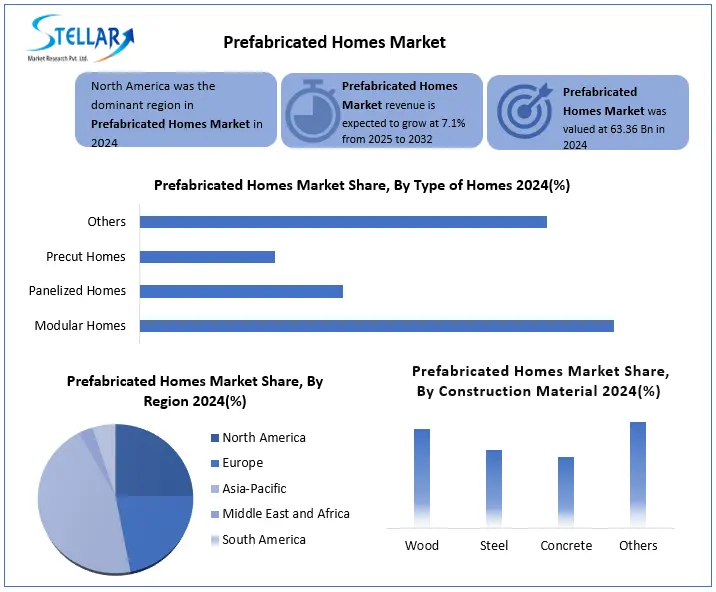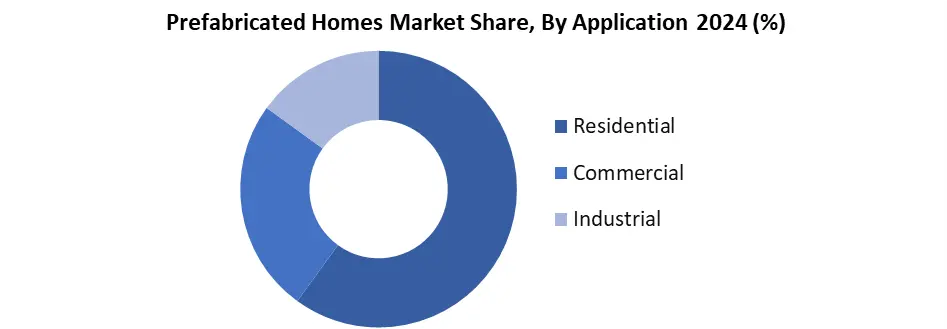Prefabricated Homes Market: Size, Share, Trends, By Construction Material, By Application, Dynamics, Key Players, and Forecast 2025-2032
The Prefabricated Homes Market was estimated at USD 36.60 Bn in 2024 and is expected to grow at a CAGR of 7.1% from 2025 to 2032, reaching nearly USD 63.36 Bn by 2032
Format : PDF | Report ID : SMR_2781
Prefabricated Homes Market Overview
Prefabrication refers to the process of manufacturing and assembling building components or entire structures in a factory or off-site location, before transporting and installing them at the final building site.
The prefabricated Homes Market is growing by increasing cheap, durable and quickly installed housing solutions. The prefabricated homes built by off-site construction techniques meet a wide range of consumers, including residential buyers, government housing projects and emergency housing needs. Prefabricated houses are built at faster and low cost compared to traditional construction, making them ideal for medium-income population. Governments and non -non-governmental organizations have rapidly seen prefabricated solutions as feasible to meet housing needs. Prefabricated construction allows for better waste management, integration of energy-efficient designs and renewable technologies, making it attractive to environment-conscious buyers and developers. Building information modeling (BIM), 3D printing and integration of robotics, the capacity of well-organized, efficient construction processes has never been high. BIM allows architects and builders to design with levels of accuracy and foresight that reduces margins for error, which enables rapid response time to design changes and unexpected obstacles.

To get more Insights: Request Free Sample Report
Prefabricated Homes Market Dynamics
Urbanization and Population Growth to fuel the Prefabricated Homes Market
Rapid urbanization is a major factor for the growth of prefabricated homes. Rapid urbanization is putting pressure on the city's infrastructure and housing systems. Millions of people are going to cities every year, especially in Asia and Africa, there are immediate need for cost-effective housing that is created early and on scale. According to the United Nations, more than 56% of the world's population lived in urban areas in 2023. By 2050, it is expected to increase by 68%, which adds 2.5 billion people to urban centers, mostly in Asia and Africa. India alone will add more than 400 million urban residents, leading to its housing and infrastructure systems.
The Market Faces Restraints Related to Negative Public Perception and Social Acceptance
The most prominent restraint is negative public perception and lack of social acceptance. This issue reduces many other obstacles and is very slow in adopting the market, even in areas where prefabricated housing provides clear economic and logical benefits. This restraint is major due to people still thinking that prefabricated homes are low in quality, cheap shelters and unsafe construction. In many cultures, traditional brick-and-mortar homes are symbols of permanence, success, and status. So, these factors are limit the growth of the prefabricated homes market.
Affordable Housing Demand in Emerging Economies is an opportunity for the Prefabricated Homes Market
Rapid urbanization, population growth, and rising land and construction costs have created a significant housing difference in many countries. Governments are actively looking for scalable, fast, and cost-effective housing solutions and prefabricated homes construction is emerging as the most practical option. prefabricated houses provide a unique benefit, such as it is produced off-site on a scale and it is quickly assembled, often at 30–40% lower cost compared to traditional construction. As a result, major government housing initiatives, such as Pradhan Mantri Awas Yojana and Kenya's affordable housing program adopted fast prefab technology to meet aggressive housing goals.
Prefabricated Market Segment Analysis
Based on Construction Material, the prefabricated homes market is segmented into wood, steel, concrete, and other. The wood segment dominated the Market in 2024 and is expected to hold the largest Market share over the forecast period (2025-2032). Wooden construction material is known for its ease of construction and cost-effectiveness. The primary reason is that it is light and flexible in nature, which makes it an ideal option for off-site construction and on-site assembly. This makes wood an attractive option for both individual home owners and large -scale housing projects, where speed and scalability are necessary. In addition, wood is also popular for its environmental and aesthetic value.
Based on Application, the prefabricated homes market is segmented into residential, commercial, and industrial. The residential segment dominated the market in 2024 and is expected to hold the largest Market share over the forecast period (2025-2032). The residential section dominated due to the increasing requirement of inexpensive, sharp and scalable housing solutions, especially in areas with rapid urbanization, and residential area increases commercial, industrial and emergency-use applications. Countries of Asia-Pacific, Africa and South America are seeing dramatic growth in urban migration, which requires a significant requirement for congested cities and affordable housing. By 2024, the market has more than 60–65% of the market revenue of total prefabricated houses globally in the residential section.

Prefabricated Homes Market Regional Analysis:
The Asia Pacific region dominated the Market in 2024 and is expected to hold the largest Market share over the forecast period (2024-2032)
The dominance of Asia Pacific region is due to the rapid urbanization, population growth, increasing housing demand, and strong government intervention. Countries such as China, India, Japan, Indonesia, and Australia are at the forefront of adopting prefabricated home construction in areas of residential and public infrastructure. In China, the government has set ambitious targets to pretend 30% of all new buildings by 2030 as part of their national green building strategy. Major state-owned and private construction firms are investing heavy in modular factories and automatic production lines to meet this goal. India is another significant contributor to APAC dominance, as it faces a shortage of urban housing more than 18 million units. Under the initiatives like Pradhan Mantri Awas Yojana and Smart Cities Mission, pre-made houses are being used for low-income housing and rapid urban expansion.
Prefabricated Homes Market Competitive Landscape
The prefabricated Homes market is highly competitive in which major players compete on the basis of technology, adaptation, costs, and stability, with increasing attention to innovation in materials and smart home integration. The major companies such as Sekisui House Limited, Lennar Corporation, Prefab Logic, Champion Home Builders and clever houses are dominating the market.

|
Prefabricated Homes Market Scope |
|
|
Market Size in 2024 |
USD 36.60 Bn |
|
Market Size in 2032 |
USD 63.36 Bn |
|
CAGR (2024-2032) |
7.1% |
|
Historic Data |
2019-2023 |
|
Base Year |
2024 |
|
Forecast Period |
2025-2032 |
|
Segments |
By Construction Material Wood Steel Concrete Others |
|
By Application Residential Commercial Industrial |
|
|
By Type of Home Modular Homes Panelized Homes Pre-Cut Homes Others |
|
|
Regional Scope |
North America- United States, Canada, and Mexico Europe – UK, France, Germany, Italy, Spain, Sweden, Russia, and Rest of Europe Asia Pacific – China, South Korea, Japan, India, Australia, Indonesia, Philippines, Malaysia, Vietnam, Thailand, Rest of APAC Middle East and Africa - South Africa, GCC, Egypt, Nigeria, Rest of the Middle East and Africa South America – Brazil, Argentina, Rest of South America |
Key Players in the Prefabricated Homes Market
North America
- Champion Home Builders (United States)
- Clayton Homes (United States)
- Cavco Industries, Inc. (United States)
- Prefab Logic (United States)
- Unity Homes (United States)
- Method Homes (United States)
- Connect Homes (United States)
Europe
- Laing O’Rourke (United Kingdom)
- Skanska AB (Sweden)
- Huf Haus (Germany)
- Ilke Homes (United Kingdom)
- TopHat Industries (United Kingdom)
Asia-Pacific
- Broad Sustainable Building (BSB)(China)
- CIMC Modular Building Systems (China)
- Sekisui House, Ltd. (Japan)
- Daiwa House Industry Co., Ltd. (Japan)
- Tata Steel Nest-In (India)
- Fleetwood Australia (Australia)
Frequently Asked Questions
Urbanization and Population Growth to boost the Prefabricated Homes Market.
Sekisui House, Ltd., Lennar Corporation, Prefab Logic, Champion Home Builders, and Clever Homes are the key competitors in the Prefabricated Homes Market.
Affordable Housing Demand in Emerging Economies is an opportunity for the Prefabricated Homes Market.
The residential segment dominated the Prefabricated Homes Market.
1. Prefabricated Homes Market Introduction
1.1. Study Assumption and Market Definition
1.2. Scope of the Study
1.3. Executive Summary
2. Global Prefabricated Homes Market: Competitive Landscape
2.1. SMR Competition Matrix
2.2. Competitive Landscape
2.3. Key Players Benchmarking
2.3.1. Company Name
2.3.2. Product Segment
2.3.3. Distribution Channel Segment
2.3.4. Revenue (2024)
2.4. Leading Prefabricated Homes Market Companies, by Market Capitalization
2.5. Market Structure
2.5.1. Market Leaders
2.5.2. Market Followers
2.5.3. Emerging Players
2.6. Mergers and Acquisitions Details
3. Prefabricated Homes Market: Dynamics
3.1. Prefabricated Homes Market Trends by Region
3.1.1. North America Prefabricated Homes Market Trends
3.1.2. Europe Prefabricated Homes Market Trends
3.1.3. Asia Pacific Prefabricated Homes Market Trends
3.1.4. Middle East & Africa Prefabricated Homes Market Trends
3.1.5. South America Prefabricated Homes Market Trends
3.2. Prefabricated Homes Market Dynamics by Global
3.3. PORTER’s Five Forces Analysis
3.4. PESTLE Analysis
3.5. Value Chain Analysis
3.6. Regulatory Landscape by Region
3.6.1. North America
3.6.2. Europe
3.6.3. Asia Pacific
3.6.4. Middle East & Africa
3.6.5. South America
4. Prefabricated Homes Market: Global Market Size and Forecast by Segmentation (by Value USD Bn) (2024-2032)
4.1. Prefabricated Homes Market Size and Forecast, By Construction Material (2024-2032)
4.1.1. Wood
4.1.2. Steel
4.1.3. Concrete
4.1.4. Others
4.2. Prefabricated Homes Market Size and Forecast, By Application (2024-2032)
4.2.1. Residential
4.2.2. Commercial
4.2.3. Industrial
4.3. Prefabricated Homes Market Size and Forecast, By Type of Home (2024-2032)
4.3.1. Modular Homes
4.3.2. Panelized Homes
4.3.3. Pre-Cut Homes
4.3.4. Others
4.4. Prefabricated Homes Market Size and Forecast, By Region (2024-2032)
4.4.1. North America
4.4.2. Europe
4.4.3. Asia Pacific
4.4.4. Middle East & Africa
4.4.5. South America
5. North America Prefabricated Homes Market Size and Forecast by Segmentation (by Value USD Bn) (2024-2032)
5.1. North America Prefabricated Homes Market Size and Forecast, By Construction Material (2024-2032)
5.1.1. Wood
5.1.2. Steel
5.1.3. Concrete
5.1.4. Others
5.2. North America Prefabricated Homes Market Size and Forecast, By Application (2024-2032)
5.2.1. Residential
5.2.2. Commercial
5.2.3. Industrial
5.3. North America Prefabricated Homes Market Size and Forecast, By Type of Home (2024-2032)
5.3.1. Modular Homes
5.3.2. Panelized Homes
5.3.3. Pre-Cut Homes
5.3.4. Others
5.4. North America Prefabricated Homes Market Size and Forecast, by Country (2024-2032)
5.4.1. United States
5.4.1.1. United States Prefabricated Homes Market Size and Forecast, By Construction Material (2024-2032)
5.4.1.1.1. Wood
5.4.1.1.2. Steel
5.4.1.1.3. Concrete
5.4.1.1.4. Others
5.4.1.2. United States Prefabricated Homes Market Size and Forecast, By Application (2024-2032)
5.4.1.2.1. Residential
5.4.1.2.2. Commercial
5.4.1.2.3. Industrial
5.4.1.3. United States Prefabricated Homes Market Size and Forecast, By Type of Home (2024-2032)
5.4.1.3.1. Modular Homes
5.4.1.3.2. Panelized Homes
5.4.1.3.3. Pre-Cut Homes
5.4.1.3.4. Others
5.4.2. Canada
5.4.2.1. Canada Prefabricated Homes Market Size and Forecast, By Construction Material (2024-2032)
5.4.2.1.1. Wood
5.4.2.1.2. Steel
5.4.2.1.3. Concrete
5.4.2.1.4. Others
5.4.2.2. Canada Prefabricated Homes Market Size and Forecast, By Application (2024-2032)
5.4.2.2.1. Residential
5.4.2.2.2. Commercial
5.4.2.2.3. Industrial
5.4.2.3. Canada Prefabricated Homes Market Size and Forecast, By Type of Home (2024-2032)
5.4.2.3.1. Modular Homes
5.4.2.3.2. Panelized Homes
5.4.2.3.3. Pre-Cut Homes
5.4.2.3.4. Others
5.4.3. Mexico
5.4.3.1. Mexico Prefabricated Homes Market Size and Forecast, By Construction Material (2024-2032)
5.4.3.1.1. Wood
5.4.3.1.2. Steel
5.4.3.1.3. Concrete
5.4.3.1.4. Others
5.4.3.2. Mexico Prefabricated Homes Market Size and Forecast, By Application (2024-2032)
5.4.3.2.1. Residential
5.4.3.2.2. Commercial
5.4.3.2.3. Industrial
5.4.3.3. Mexico Prefabricated Homes Market Size and Forecast, By Type of Home (2024-2032)
5.4.3.3.1. Modular Homes
5.4.3.3.2. Panelized Homes
5.4.3.3.3. Pre-Cut Homes
5.4.3.3.4. Others
6. Europe Prefabricated Homes Market Size and Forecast by Segmentation (by Value USD Bn) (2024-2032)
6.1. Europe Prefabricated Homes Market Size and Forecast, By Construction Material (2024-2032)
6.2. Europe Prefabricated Homes Market Size and Forecast, By Application (2024-2032)
6.3. Europe Prefabricated Homes Market Size and Forecast, By Type of Home (2024-2032)
6.4. Europe Prefabricated Homes Market Size and Forecast, by Country (2024-2032)
6.4.1. United Kingdom
6.4.1.1. United Kingdom Prefabricated Homes Market Size and Forecast, By Construction Material (2024-2032)
6.4.1.2. United Kingdom Prefabricated Homes Market Size and Forecast, By Application (2024-2032)
6.4.1.3. United Kingdom Prefabricated Homes Market Size and Forecast, By Type of Home (2024-2032)
6.4.2. France
6.4.2.1. France Prefabricated Homes Market Size and Forecast, By Construction Material (2024-2032)
6.4.2.2. France Prefabricated Homes Market Size and Forecast, By Application (2024-2032)
6.4.2.3. France Prefabricated Homes Market Size and Forecast, By Type of Home (2024-2032)
6.4.3. Germany
6.4.3.1. Germany Prefabricated Homes Market Size and Forecast, By Construction Material (2024-2032)
6.4.3.2. Germany Prefabricated Homes Market Size and Forecast, By Application (2024-2032)
6.4.3.3. Germany Prefabricated Homes Market Size and Forecast, By Type of Home (2024-2032)
6.4.4. Italy
6.4.4.1. Italy Prefabricated Homes Market Size and Forecast, By Construction Material (2024-2032)
6.4.4.2. Italy Prefabricated Homes Market Size and Forecast, By Application (2024-2032)
6.4.4.3. Italy Prefabricated Homes Market Size and Forecast, By Type of Home (2024-2032)
6.4.5. Spain
6.4.5.1. Spain Prefabricated Homes Market Size and Forecast, By Construction Material (2024-2032)
6.4.5.2. Spain Prefabricated Homes Market Size and Forecast, By Application (2024-2032)
6.4.5.3. Spain Prefabricated Homes Market Size and Forecast, By Type of Home (2024-2032)
6.4.6. Sweden
6.4.6.1. Sweden Prefabricated Homes Market Size and Forecast, By Construction Material (2024-2032)
6.4.6.2. Sweden Prefabricated Homes Market Size and Forecast, By Application (2024-2032)
6.4.6.3. Sweden Prefabricated Homes Market Size and Forecast, By Type of Home (2024-2032)
6.4.7. Austria
6.4.7.1. Austria Prefabricated Homes Market Size and Forecast, By Construction Material (2024-2032)
6.4.7.2. Austria Prefabricated Homes Market Size and Forecast, By Application (2024-2032)
6.4.7.3. Austria Prefabricated Homes Market Size and Forecast, By Type of Home (2024-2032)
6.4.8. Rest of Europe
6.4.8.1. Rest of Europe Prefabricated Homes Market Size and Forecast, By Construction Material (2024-2032)
6.4.8.2. Rest of Europe Prefabricated Homes Market Size and Forecast, By Application (2024-2032)
6.4.8.3. Rest of Europe Prefabricated Homes Market Size and Forecast, By Type of Home (2024-2032)
7. Asia Pacific Prefabricated Homes Market Size and Forecast by Segmentation (by Value USD Bn) (2024-2032)
7.1. Asia Pacific Prefabricated Homes Market Size and Forecast, By Construction Material (2024-2032)
7.2. Asia Pacific Prefabricated Homes Market Size and Forecast, By Application (2024-2032)
7.3. Asia Pacific Prefabricated Homes Market Size and Forecast, By Type of Home (2024-2032)
7.4. Asia Pacific Prefabricated Homes Market Size and Forecast, by Country (2024-2032)
7.4.1. China
7.4.1.1. China Prefabricated Homes Market Size and Forecast, By Construction Material (2024-2032)
7.4.1.2. China Prefabricated Homes Market Size and Forecast, By Application (2024-2032)
7.4.1.3. China Prefabricated Homes Market Size and Forecast, By Type of Home (2024-2032)
7.4.2. S Korea
7.4.2.1. S Korea Prefabricated Homes Market Size and Forecast, By Construction Material (2024-2032)
7.4.2.2. S Korea Prefabricated Homes Market Size and Forecast, By Application (2024-2032)
7.4.2.3. S Korea Prefabricated Homes Market Size and Forecast, By Type of Home (2024-2032)
7.4.3. Japan
7.4.3.1. Japan Prefabricated Homes Market Size and Forecast, By Construction Material (2024-2032)
7.4.3.2. Japan Prefabricated Homes Market Size and Forecast, By Application (2024-2032)
7.4.3.3. Japan Prefabricated Homes Market Size and Forecast, By Type of Home (2024-2032)
7.4.4. India
7.4.4.1. India Prefabricated Homes Market Size and Forecast, By Construction Material (2024-2032)
7.4.4.2. India Prefabricated Homes Market Size and Forecast, By Application (2024-2032)
7.4.4.3. India Prefabricated Homes Market Size and Forecast, By Type of Home (2024-2032)
7.4.5. Australia
7.4.5.1. Australia Prefabricated Homes Market Size and Forecast, By Construction Material (2024-2032)
7.4.5.2. Australia Prefabricated Homes Market Size and Forecast, By Application (2024-2032)
7.4.5.3. Australia Prefabricated Homes Market Size and Forecast, By Type of Home (2024-2032)
7.4.6. Indonesia
7.4.6.1. Indonesia Prefabricated Homes Market Size and Forecast, By Construction Material (2024-2032)
7.4.6.2. Indonesia Prefabricated Homes Market Size and Forecast, By Application (2024-2032)
7.4.6.3. Indonesia Prefabricated Homes Market Size and Forecast, By Type of Home (2024-2032)
7.4.7. Philippines
7.4.7.1. Philippines Prefabricated Homes Market Size and Forecast, By Construction Material (2024-2032)
7.4.7.2. Philippines Prefabricated Homes Market Size and Forecast, By Application (2024-2032)
7.4.7.3. Philippines Prefabricated Homes Market Size and Forecast, By Type of Home (2024-2032)
7.4.8. Malaysia
7.4.8.1. Malaysia Prefabricated Homes Market Size and Forecast, By Construction Material (2024-2032)
7.4.8.2. Malaysia Prefabricated Homes Market Size and Forecast, By Application (2024-2032)
7.4.8.3. Malaysia Prefabricated Homes Market Size and Forecast, By Type of Home (2024-2032)
7.4.9. Vietnam
7.4.9.1. Vietnam Prefabricated Homes Market Size and Forecast, By Construction Material (2024-2032)
7.4.9.2. Vietnam Prefabricated Homes Market Size and Forecast, By Application (2024-2032)
7.4.9.3. Vietnam Prefabricated Homes Market Size and Forecast, By Type of Home (2024-2032)
7.4.10. Thailand
7.4.10.1. Thailand Prefabricated Homes Market Size and Forecast, By Construction Material (2024-2032)
7.4.10.2. Thailand Prefabricated Homes Market Size and Forecast, By Application (2024-2032)
7.4.10.3. Thailand Prefabricated Homes Market Size and Forecast, By Type of Home (2024-2032)
7.4.11. ASEAN
7.4.11.1. ASEAN Prefabricated Homes Market Size and Forecast, By Construction Material (2024-2032)
7.4.11.2. ASEAN Prefabricated Homes Market Size and Forecast, By Application (2024-2032)
7.4.11.3. ASEAN Prefabricated Homes Market Size and Forecast, By Type of Home (2024-2032)
7.4.12. Rest of Asia Pacific
7.4.12.1. Rest of Asia Pacific Prefabricated Homes Market Size and Forecast, By Construction Material (2024-2032)
7.4.12.2. Rest of Asia Pacific Prefabricated Homes Market Size and Forecast, By Application (2024-2032)
7.4.12.3. Rest of Asia Pacific Prefabricated Homes Market Size and Forecast, By Type of Home (2024-2032)
8. Middle East and Africa Prefabricated Homes Market Size and Forecast by Segmentation (by Value USD Bn) (2024-2032)
8.1. Middle East and Africa Prefabricated Homes Market Size and Forecast, By Construction Material (2024-2032)
8.2. Middle East and Africa Prefabricated Homes Market Size and Forecast, By Application Model (2024-2032)
8.3. Middle East and Africa Prefabricated Homes Market Size and Forecast, By Type of Home (2024-2032)
8.4. Middle East and Africa Prefabricated Homes Market Size and Forecast, by Country (2024-2032)
8.4.1. South Africa
8.4.1.1. South Africa Prefabricated Homes Market Size and Forecast, By Construction Material (2024-2032)
8.4.1.2. South Africa Prefabricated Homes Market Size and Forecast, By Application Model (2024-2032)
8.4.1.3. South Africa Prefabricated Homes Market Size and Forecast, By Type of Home (2024-2032)
8.4.2. GCC
8.4.2.1. GCC Prefabricated Homes Market Size and Forecast, By Construction Material (2024-2032)
8.4.2.2. GCC Prefabricated Homes Market Size and Forecast, By Application Model (2024-2032)
8.4.2.3. GCC Prefabricated Homes Market Size and Forecast, By Type of Home (2024-2032)
8.4.3. Nigeria
8.4.3.1. Nigeria Prefabricated Homes Market Size and Forecast, By Construction Material (2024-2032)
8.4.3.2. Nigeria Prefabricated Homes Market Size and Forecast, By Application Model (2024-2032)
8.4.3.3. Nigeria Prefabricated Homes Market Size and Forecast, By Type of Home (2024-2032)
8.4.4. Rest of ME&A
8.4.4.1. Rest of ME&A Prefabricated Homes Market Size and Forecast, By Construction Material (2024-2032)
8.4.4.2. Rest of ME&A Prefabricated Homes Market Size and Forecast, By Application Model (2024-2032)
8.4.4.3. Rest of ME&A Prefabricated Homes Market Size and Forecast, By Type of Home (2024-2032)
9. South America Prefabricated Homes Market Size and Forecast by Segmentation (by Value USD Bn) (2024-2032)
9.1. South America Prefabricated Homes Market Size and Forecast, By Construction Material (2024-2032)
9.2. South America Prefabricated Homes Market Size and Forecast, By Application (2024-2032)
9.3. South America Prefabricated Homes Market Size and Forecast, By Type of Home (2024-2032)
9.4. South America Prefabricated Homes Market Size and Forecast, by Country (2024-2032)
9.4.1. Brazil
9.4.1.1. Brazil Prefabricated Homes Market Size and Forecast, By Construction Material (2024-2032)
9.4.1.2. Brazil Prefabricated Homes Market Size and Forecast, By Application (2024-2032)
9.4.1.3. Brazil Prefabricated Homes Market Size and Forecast, By Type of Home (2024-2032)
9.4.2. Argentina
9.4.2.1. Argentina Prefabricated Homes Market Size and Forecast, By Construction Material (2024-2032)
9.4.2.2. Argentina Prefabricated Homes Market Size and Forecast, By Application (2024-2032)
9.4.2.3. Argentina Prefabricated Homes Market Size and Forecast, By Type of Home (2024-2032)
9.4.3. Rest of South America
9.4.3.1. Rest of South America Prefabricated Homes Market Size and Forecast, By Construction Material (2024-2032)
9.4.3.2. Rest of South America Prefabricated Homes Market Size and Forecast, By Application (2024-2032)
9.4.3.3. Rest of South America Prefabricated Homes Market Size and Forecast, By Type of Home (2024-2032)
10. Company Profile: Key Players
10.1 Champion Home Builders (United States)
10.1.1. Company Overview
10.1.2. Business Portfolio
10.1.3. Financial Overview
10.1.4. SWOT Analysis
10.1.5. Strategic Analysis
10.1.6. Recent Development
10.2 Clayton Homes (United States)
10.3 Cavco Industries, Inc. (United States)
10.4 Prefab Logic (United States)
10.5 Unity Homes (United States)
10.6 Method Homes (United States)
10.7 Connect Homes (United States)
10.8 Laing O’Rourke (United Kingdom)
10.9 Skanska AB (Sweden)
10.10 Huf Haus (Germany)
10.11 Ilke Homes (United Kingdom)
10.12 TopHat Industries (United Kingdom)
10.13 CIMC Modular Building Systems (China)
10.14 Broad Sustainable Building (BSB)(China)
10.15 Sekisui House, Ltd. (Japan)
10.16 Daiwa House Industry Co., Ltd. (Japan)
10.17 Tata Steel Nest-In (India)
10.18 Fleetwood Australia (Australia)
11. Key Findings & Analyst Recommendations
12. Prefabricated Homes Markets: Research Methodology
















